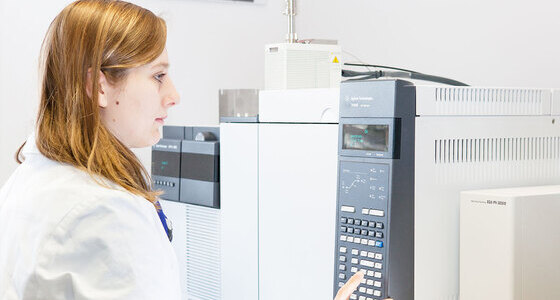Pyrolysis Gas Chromatography/Mass Spectrometry
Pyrolysis Gas Chromatography/Mass Spectrometry (Pyrolysis-GC-MS) is an analytical tool used to characterize a wide variety of polymers and composite materials that cannot be analyzed using traditional GC-MS. The fundamental concept of Pyrolysis-GC-MS is not complicated but highly sensitive. A sample is introduced to a heated environment and is broken down into smaller stable fragments/components (aka pyrolyzates) for analysis. The pyrolyzates are then chromatographically separated in the same manner as traditional GC-MS. Similar to traditional GC-MS, the fragments are separated utilizing a compound’s intrinsic affinity for a “stationary phase” (solid support with specialized coating). Once the pyrolyzates are separated, the data is analyzed by highly skilled scientists who can deconvolute and interpret the data and subsequently provide useful information and insight on the original material.

In order to conduct a thorough investigation, the Pyrolysis temperature program must be set up in a very specific way. When a sample is introduced into the Pyrolysis unit, it is instantly heated from ambient to the desired temperature in an inert atmosphere. This rapid heating provides reproducible results. If additional tests are needed, the test sample is cooled in an inert atmosphere to room temperature and the Pyrolysis unit is reprogrammed. Several different experiments can be performed and they are explained below.
Types of Pyrolysis-GC-MS Analyses
- A Single Shot Pyrolysis-GC-MS: The single shot is run at a single temperature, normally >500°C (dependent on the material being examined). The temperature of the sample is rapidly increased at a temperature rate <20 msec to break bonds. This is done in order to characterize the original sample.
- A Double Shot Pyrolysis: This is normally run at both low (80-350°C) and high temperatures (500-800°C). The lower temperature analysis is known as a thermal desorption step. This step can be used to examine low molecular weight components (monomers, oligomers, etc.), additives and residual solvents. The higher temperatures allow for the total fragmentation of the higher molecular weight items such as the crosslinked material or the entire polymer backbone.
- Evolved Gas Analysis (EGA): This is run by dropping the sample into the Pyrolysis unit set at a low temperature. The furnace is then increased to a high temperature at a set ramp rate. The components that are off-gassed/evolved from the sample are then examined. This testing is done in order to identify the temperature range for the desired component. The Pyrolysis-GC-MS can then be set up the desired temperature range for a more in-depth study of the identified compound. As a side note, Thermal Gravimetric Analysis (TGA) can also be used to aid in the determination of the temperature analysis profile for Pyrolysis-GC-MS.
- Low Temperature (normally considered <350°C) Thermal Desorption: This testing would be done for products where additives, residual solvents or other off-gassed components are desired but the polymer identification is not needed.
- Reactive Pyrolysis-GC-MS: There are certain classes of compounds, for example polyesters, that have complex Pyrolysis mixtures (i.e. many degradation products, etc.). These complex mixtures make the interpretation of the data difficult, if not impossible. When a derivatization technique is utilized, a chemical reaction occurs while the sample is in the Pyrolysis chamber, allowing for a much easier interpretation of the derivatized products.
- Heart Cut-EGA GC-MS (HC-EGA-GC-MS): This method is useful when looking for specific components in a highly complex matrix or when the full composition of a complex system is desired. Heart-Cut Pyrolysis involves using the EGA technique to isolate the desired elution times (i.e. zones). The instrument is then programmed to isolate each specified zone identified by EGA. Each zone is then individually analyzed. This technique allows for the examination of regions that might contain multiple components under one peak but are not obvious during the regular Pyrolysis GC-MS analysis. While extremely useful, this technique can add to the complexity and amount of time for the analysis.
- Quantitative Pyrolysis-GC-MS: This would be done on a component that the amount present could not be determined using another technique. An example component would be a low ppm additive (such as an Irganox, Irgafos, etc.), FAME components in rubbers, phthalates plus many other compounds.
- Cryotrapping capabilities are available for the Pyrolysis GC-MS. Prior to introduction into the GC-MS, the pyrolyzates are cryotrapped using liquid nitrogen. This is done to narrow the chromatographic band and improve the detection limit.
Pyrolysis-GC-MS virtually eliminates the need for the various sample preparation techniques required by traditional GC-MS (extraction, dilutions, concentrating the sample, various chemical reactions, heating/cooling, etc. are unnecessary). The samples can be analyzed in an “as received” state unless they fall into the category of needing reactive Pyrolysis-GC-MS.
Ideal Uses of Pyro-GC-MS
- Polymer identification
- Additive identification
- Qualitative and quantitative analysis of components
- Materials that are not suitable for direct GC-MS
Strengths
- Can examine materials and compounds that are not suitable for traditional GC-MS
- Able to study polymeric structures from pure systems to multiple block polymers
- Micrograms of samples are used for analysis
- Reduced sample preparation
Limitations
- Non-homogenous samples might have variable results
- Does not detect most inorganic components
- Pyrolysis-GC-MS is a destructive technique
Pyro-GC-MS Technical Specifications
- Detection limit: determined by the component being analyzed – most components seen in the ppm range
- Temperature range: 30°C to 800°C
- Ramp rates: can vary from 1°C/minute to 100°C/minute
- Nitrogen purged environment
